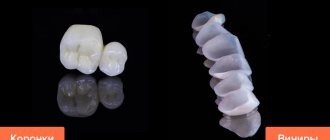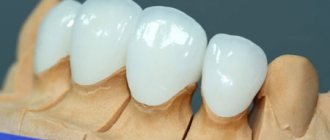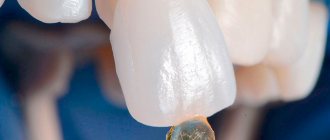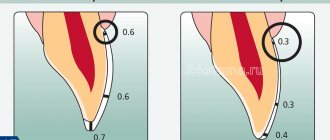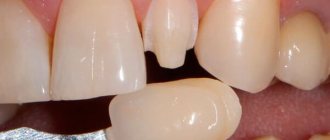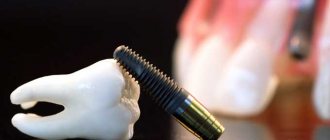What are zirconium dioxide veneers and their features
Veneers are permanent microprostheses in the form of overlays that are fixed on the front surface of the teeth and hide chips, enamel damage, and color irregularities. Zirconium onlays, or rather, those created from zirconium dioxide (it is obtained by chemical and thermal treatment of natural zirconium compounds). Zirconium veneers (although it is correct to say “dioxide”, and not just zircon or zirconium) are characterized by increased strength and high aesthetics (see photo) and reliable adhesion to the surface of the teeth.The service life of zirconium dioxide veneers is 2-3 times longer than that of conventional ceramic ones.
Zirconium dioxide is very durable (exceeds metal in strength, but is 2 times lighter) and lends itself well to modern processing methods - so microprostheses are very thin. Despite this, due to their low transparency, they do not allow the original color imperfections of the teeth to pass through. For example, if there are dark spots.
Pros and cons of zirconium veneers
It is no coincidence that zirconium veneers are increasingly used by dentists today. They have a number of obvious advantages, but there are also disadvantages.
- Durability, ability to withstand heavy chewing load.
- Consistency of shade under different lighting, including ultraviolet.
- The materials of zirconium veneers are biocompatible with human tissues, do not cause rejection or allergies, the body perceives them as its own tissues.
- Resistant to dyes, including tea and coffee.
- Possibility of use in complex clinical cases.
- Resistant to sudden temperature changes (protection for sensitive teeth).
- The procedure takes longer because the material is difficult to fix on the tooth surface.
- Installation requires significant tooth grinding. Once the plates are installed, it will no longer be possible to return the teeth to their original state.
- The price of zirconium veneers is quite high, which is due to the complexity of the procedure and the use of expensive equipment.
Indications for use
- chipped enamel, cracks in teeth,
- spaces between front teeth,
- increased abrasion of enamel,
- complex color changes in enamel: stains and yellowing, fluorosis, “tetracycline” teeth, and in cases where whitening does not produce visible results,
- mild curvature of teeth,
- weak, sensitive or underdeveloped tooth enamel.
Unlike all-ceramic or porcelain, microprostheses made of zirconium dioxide can be used even in the most complex clinical cases. For example, when the teeth “look” at each other, are slightly rotated around their axis, there are very large gaps, or the color of the enamel is changed so much that it can even show through the ceramic.
Reviews
Last year, the dentist restored four upper front teeth, which contained extensive carious cavities. I managed with photopolymer fillings. I did everything in one visit, although I spent 8 hours in a chair with my mouth open, but the result was excellent. He selected the material in such a way that no one doubts the naturalness of the shade. When asked about veneers, he replied that this was not my option.
Olga
I was always a big fan of sweets and was afraid of dentists. By the age of 25, I was embarrassed not only to smile, but even to talk, not to mention the pain. Then for many years I went to different doctors, treated and restored. I stopped suffering, but the complex remained. I recently got veneers for my entire smile and have calmed down.
Konstantin
I once really wanted to whiten my enamel, but (according to the doctor) I had thin and sensitive enamel. But he talked about veneers and that it is necessary to remove a layer of enamel from all teeth in order to glue the plates. At this point in the story I felt somehow unwell and even completely uninterested.
Evgeniya
Everyone has their own material capabilities and ideas about beauty.
I have had a metal-ceramic crown on my front tooth for 15 years now, and I only think about it in the dentist’s office. I am still grateful to the master of his craft who staged it then. Oksana
Contraindications for wearing
The dentist may refuse to install veneers on the patient if there is a large amount of tartar and plaque on the teeth (they need to be removed first) or if it is impossible to carry out thorough oral care. If a person has caries, stomatitis or gingivitis, or old fillings (in need of replacement), then these problems must first be solved.
Any microprosthesis needs good support, so veneers are not installed if the top of the tooth is chipped by more than 50%, or there are very large fillings on it.
An absolute contraindication would be the presence of chronic periodontitis or periodontal disease, accompanied by gum loss, loose teeth, and prolonged inflammatory processes. If serious curvatures of the dentition, displacement, or bruxism are detected, then zirconium onlays cannot be installed here either, because You should first undergo treatment from an orthodontist (and a neurologist for bruxism).
The difference is in installation technology.
Both veneers and crowns are made in the laboratory by a dental technician using a preliminary impression. The main difference in installation is the preparation of teeth for restoration. Veneers are superior to crowns because their installation causes the least amount of trauma to the tooth tissue. To install these thin onlays, the doctor prepares only the front part of the tooth, removing a layer of enamel according to the thickness of the plate of approximately 0.5 mm. There is no pain or discomfort during and after the procedure; there is no need to get used to the veneers. If lumineers are installed, then turning is not required. When preparing a tooth for prosthetics with a crown, the teeth are ground on all sides in accordance with the thickness of the prosthesis of approximately 2 mm. Most often, it is necessary to do depulpation; after installing the crown, there are usually some inconveniences, and you have to get used to the prosthesis. Inflammatory processes may also occur on the gums at the site of contact with the prosthesis. A good experienced dentist will help you make the right decision about the right method of prosthetics. The doctor will assess the condition of the teeth and oral cavity and give professional recommendations on the method of restoring the frontal dentition.
Advantages and disadvantages
The benefits of zirconium veneers are as follows:
- aesthetics - at the highest level and for a very long time: the color and shape of the overlays are preserved, and they are also resistant to stress and food coloring,
- perfect fit to the tooth and gum: the absence of micro-gaps eliminates the risk of microbial penetration,
- minimal thickness, can often be placed on teeth without grinding, especially if dioxide is used in its pure form - without ceramic coating,
- material strength and tooth protection: zirconium onlays can withstand high and low temperatures, acids and alkalis. They also prevent chipping because they grip the cutting edge of the tooth,
- hypoallergenic material,
- antagonist teeth are not injured: zirconium dioxide is more flexible compared to metal (which often serves as the basis for artificial crowns and is lined with ceramics),
- the ability to quickly correct defects without braces,
- the ability to restore either 1 tooth or 6-8 at once.
Don't know what type of prosthetics to choose?
We will help in the selection, advise where to read more information and compare types of prosthetics.
Consultation with an orthopedic doctor in Moscow clinics is free! Call now or request a call
Working hours: from 9:00 to 21:00 - seven days a week
Like any other microprostheses, zirconium veneers have disadvantages:
- need enamel turning,
- Zirconium dioxide is usually white in color without obvious translucency: this is true for most manufacturers. But the most progressive companies have learned to make translucent zirconium blocks, painted in natural shades, • high cost, • the need for careful handling, • specialized equipment is required for the production of zirconium onlays, • not suitable for all patients due to contraindications.
Very often, to make veneers even more natural, specialists coat the milled zirconium dioxide base with ceramic materials that have the highest aesthetics and light refraction.
About the cost
Do you dream of a beautiful smile and healthy teeth? With the Virtuoso Dentistry Center, dreams come true! To make treatment affordable, we always have promotions, discounts and great deals for you. You can find out how much a crown and veneer cost per tooth on our official website in the Prices section. The installation price is included in the total price.
To find out the exact cost taking into account the selected materials, your wishes and individual characteristics, sign up for a free consultation with an orthopedic doctor at our center.
Manufacturing features and installation steps
Zirconium dioxide veneers have their own peculiarity - they are created by an indirect method. That is, in laboratory conditions, but not manually, but through automated, fully robotic milling equipment - CAD/CAM systems. Thus, the treatment process will look like this:
- preparing teeth: cleaning from plaque and stone, removing carious cavities, removing part of the enamel from the front, bottom and side areas - this is necessary so that the linings are securely fixed and do not “stick out” beyond the row. Also, for better adhesion to the microprosthesis, shallow grooves are made on the tooth surface,
- Oral scanning (or taking impressions): This is done using an intraoral 3D scanner or regular wax impressions. Casts are used to make a model and scan it directly in the laboratory. The data is loaded into a computer, where the shape and color of the prostheses are modeled (CAD technology). At this stage, the patient can familiarize himself with the future result of the treatment and express wishes regarding color/shape,
- creating veneers from a single piece of zirconium: it is impossible to process the material manually and achieve perfect accuracy. Therefore, a special computerized apparatus is used, equipped with durable cutters (CAM technology). The final adjustment, and if an additional layer of ceramic is required, is carried out by a dental technician.
- fitting and fixation: microprostheses are glued first with temporary glue, and then with a permanent, durable adhesive composition. To make sure that a person’s smile is radically changing for the better, you can look at the photos before and after installing zirconium veneers.
In general, the process of making permanent veneers takes about 1-2 weeks maximum - from the moment of preparatory work to the actual prosthetics. While manufacturing is underway, the patient wears temporary plastic onlays - which are installed after turning and taking impressions (scanning). Temporary veneering ensures the safety of the ground stump - from infection, hot food and chips, and also leaves a person’s smile attractive.
Features of care
After installation, most patients are very worried about the length of the adjustment period. It should be noted that such a process does not take much time; after 7 days a person ceases to feel the presence of foreign bodies. In most cases, complete adaptation occurs after two to three weeks.
In order for the quality of veneers to please you for many years, it is necessary to carry out regular and high-quality hygiene of the gums and teeth, carry out preventive professional teeth cleaning on time, and remove dental deposits.
Veneers are thin shells that are firmly fixed to the teeth, but it is very unwise to test this strength. That is why it is important that all dental units in the oral cavity are healthy and can fully function. If teeth are missing, you need to think about the implantation procedure, otherwise the front incisors with veneers will be subject to stress. As a result, there is a risk of product breakdowns.
It is recommended to carry out treatment, restoration and prosthetics of teeth in one clinic. Thus, a person can be sure that a team of specialists is focused on a common result. With regular visits to the dental clinic, any damage will be detected in time and the patient will receive timely help.
Popular brands of materials
The veneers themselves can be created from a single block of zirconium dioxide (Prettau brands from Zirconia Zirkonzahn or IPS e.max from Ivoclar Vivadent). Or, as already mentioned, to have an external ceramic coating (lining and pressing) - this depends on the manufacturing technology. In the first case, microprostheses are more reliable, since there is no risk of chipping the ceramic enamel.
One of the modern materials for cladding is glass ceramics or lithium disilicate, which has the strength of zirconium and the aesthetics of ceramics. Innovative transparent adhesives based on glass ceramics are used as the adhesive used to fix the onlay to the tooth.
Complex on 4 OSSTEM implants with delayed loading - 150,000 rubles.
Complex implantation Osstem (South Korea) with delayed loading after 4-6 months.
Doctor's work guarantee - up to 5 years (under an agreement on the provision of medical services) Call now or order a call
Opening hours: 24 hours a day - seven days a week
Materials used in the manufacture of veneers.
Plates made from composite have an affordable price, but do not have high practical and aesthetic indicators, since they are made from filling materials. The main problem with such veneers is the rapid change in color due to sensitivity to various types of food coloring and the tendency to chip. Ceramic onlays have similar properties to ceramic crowns. These veneers are strong, but at the same time fragile. If you are in the habit of chewing seeds, crackers, or other similar loads, they may fly off or break. Ceramic veneers are more expensive than ceramic crowns, but having found financial opportunities, a person gets a dazzling, perfect smile.
How to properly care and wear
In order for your smile to remain attractive and snow-white, you must not forget about the rules of wearing and caring for the overlays. Although zirconium is very durable, it can still break or come off the tooth if pressed hard. Therefore, orthopedists do not recommend biting off pieces of hard food (a piece of meat, raw fruits/vegetables) - only cutting them into small portions first. You should also not chew pencils, nuts, crackers, seeds, etc.
You need to clean the restorations with a brush and paste twice a day, rinse your mouth after eating - everything as usual. But paste with abrasive particles or very hard brush bristles can scratch the ceramic veneer or gums. Another important condition that many people forget about is regular visits to your dentist (2 times a year for prevention). After all, it is easier to identify any problems at an early stage than to deal with them for a long time later.
Content:
- Main differences
- Types of veneers
- Dental crowns
- Veneers or crowns - how to make a choice 4.1. When is it better to install veneers 4.2. When you can't do without crowns
- Can veneers be glued to crowns?
The wording of the question “Veneers or crowns?” not entirely true. These designs are used in different clinical situations, although they can conditionally be classified as one area in dentistry. Meanwhile, in medical practice, sometimes there are cases when the patient needs to choose what to install - a thin overlay or a full-fledged prosthesis that replaces the entire unit.
How zirconium differs from other microprostheses
The fundamental differences between zirconium veneers and classic ceramic ones1 are as follows:
- manufacturing process: it is more complex, but at the same time precise, which makes it possible to achieve almost ideal positioning of microprostheses on the teeth. They fit tightly, food residues do not get clogged into microcracks, which means there is no risk of developing caries under dentures.
- Zirconium dioxide is a very durable material: microprostheses are thinner during processing (therefore, the enamel is ground down very little) and are very resistant to stress.
Zirconium dioxide crown on an implant for the whole 70,000 rubles.
OSSTEM implant (South Korea), individual zirconium abutment, gum former, impression taking.
Creation of a Prettau zirconium crown using 3D modeling technology. Consultation with 2 doctors: an orthopedist and an implantologist for free! Call now or request a call
Opening hours: 24 hours a day - seven days a week
If we consider the differences from lumineers, then you need to know that these thinnest veneers are created using secret technologies at CERINATE. Production is carried out only in a laboratory located in the USA, and the exact composition of the material is also unknown. If a person wants lumineers, then the orthopedist will only prepare the teeth (grinding is almost never required here) and take impressions, which will be sent to the manufacturer by plane. Lumineers last longer than zirconium microprostheses.
When should crowns be placed?
If the veneer is a microprosthesis, then the crown is a single or double prosthesis (two prostheses are connected), which covers not only the front part of the tooth, but the entire tooth on all sides. Crowns are mounted on implants, pins, or prepared teeth.
The main task of a crown is to strengthen a tooth that is destroyed, maintain its anatomical shape and provide it with chewing function. Crowns are installed in the following cases.
- The hard tissues of the tooth are very damaged and cannot be restored using filling materials.
- In case of pathological abrasion of teeth to prevent further destruction.
- Elimination of serious defects such as uneven color, irregular tooth shape, abnormal growth.
- An abnormal bite that cannot be corrected with braces.
- Deep cracks and the presence of caries.
- If you have loose teeth or a large interdental gap.
Thus, if there is serious damage to the teeth, only crowns should be placed. There are no other possibilities.
Cost of microprostheses made of dioxide
The cost of zirconium veneers both in Moscow and in other cities is relatively high. They are more expensive than porcelain or ceramic onlays, but almost 1.5-2 times cheaper than expensive lumineers (besides, the latter are created abroad and become noticeably more expensive with changes in the foreign exchange market). The price of zirconium dioxide veneers starts from 30 thousand rubles for the restoration of 1 tooth, but it is worth noting that they are stronger, more aesthetically pleasing and more practical than ceramic analogues, so the financial investment is justified in the long term.
- G. Gurel, “Ceramic veneers. Art and Science", 2008
Author: Dulgarov Zh. G. (Thank you for your help in writing the article and the information provided)
Types of veneers
Microprostheses are divided into composite and porcelain. Composite ones are divided into:
- Direct
Made in the patient's mouth. Installation technology: the doctor grinds the coronal shell to a thickness of 0.3-0.7 mm and forms an overlay layer-by-layer from a material identical to that used in filling. The procedure is completed by grinding and polishing the surface of the microprosthesis. In part, the technique has something in common with artistic dental restoration.
- Indirect (componers)
They are made in a dental laboratory (like ceramic analogues). Impressions are taken from dental units prepared for restoration, from which thin plates are made using computer equipment. They have an increased precision of fit to the enamel surface. This guarantees a long service life of orthopedic structures.
When wondering which veneers are better to choose, composite or ceramic, you should first understand the features of the options. Each type has its own advantages and disadvantages in terms of aesthetics, reliability and price.

